Words: Liam Friary
Images: Jake Hood
Queenstown: the land of majestic landscapes and intrepid exploration. It’s attracted people of an adventurous spirit for eons and, on approach by aircraft, it’s not hard to see why. Golden tussock grass, craggy ranges and towering snow-capped peaks encompass the town, on the edge of Lake Whakatipu.
Queenstown begs to be explored from the moment you step off the plane, and one of the best ways to immerse yourself in the impressive landscape is by bike. For this trip, we planned to ride Queenstown, Arrowtown and Gibbston – taking our time by riding at a leisurely pace. The idea was to connect these locations by bike, then slow things down by enjoying long lunches, wine tasting and allowing plenty of time to just relax. The vibrant town and award-winning wineries are a major drawcard, and connecting these things together is The Queenstown Trail.
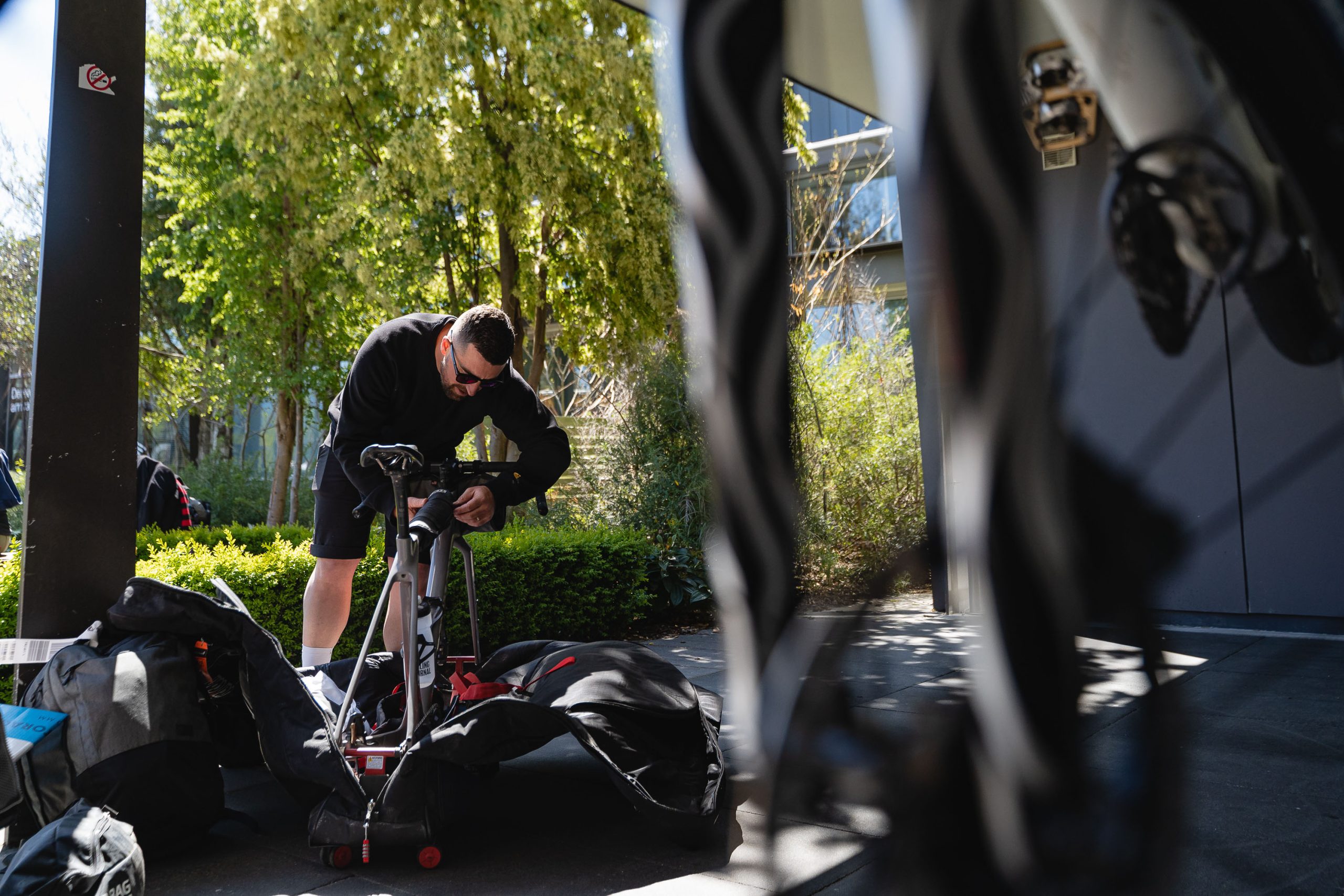
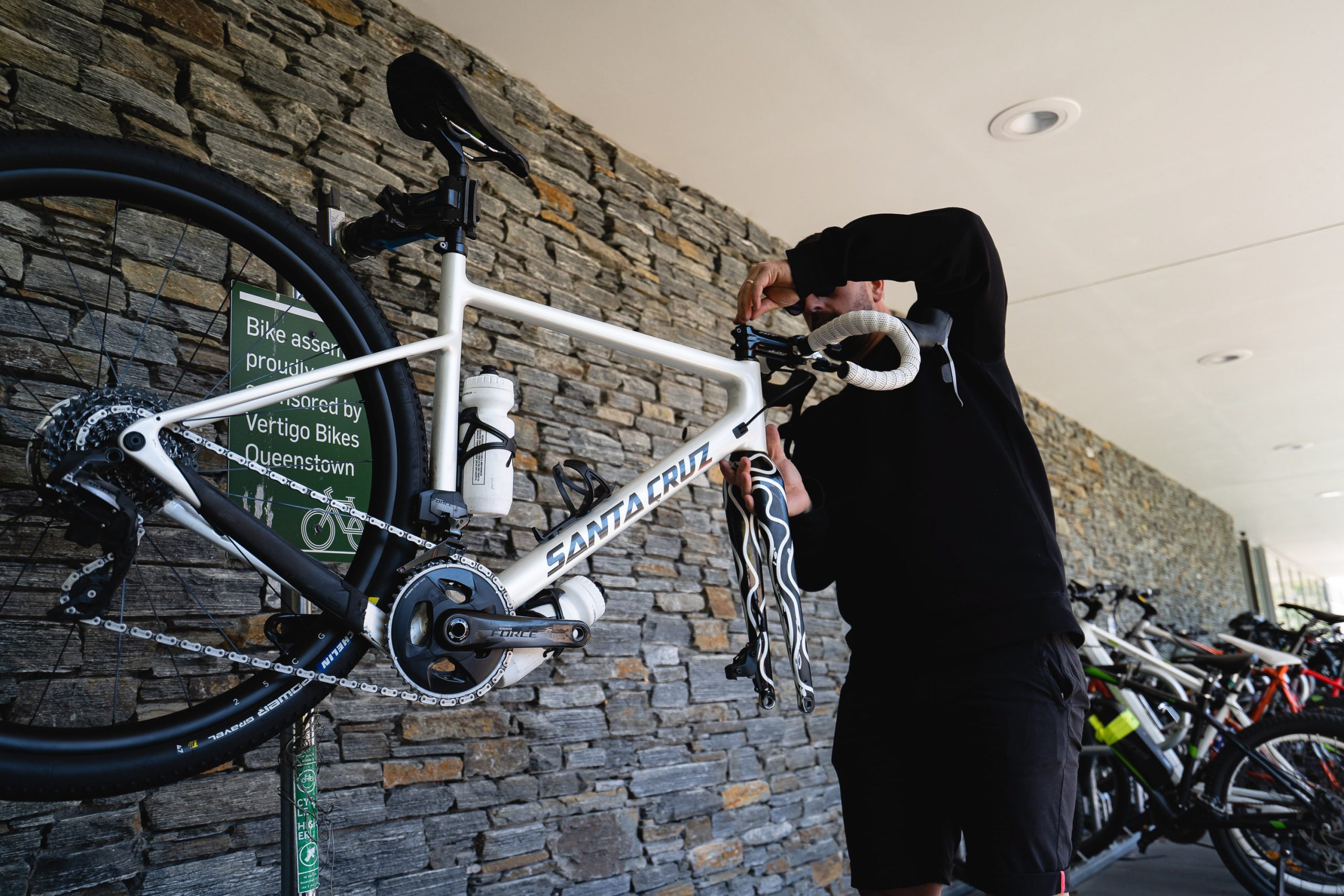
The Queenstown Trail is one of New Zealand’s 22 Great Rides. The Great Rides are a network of trails that provide a safe and sustainable way to explore some of New Zealand’s most special places. The popularity of these trails has grown immensely within the last decade, and it’s easy to see why.
Queenstown’s very own Great Ride explores 130km of off-road trails and can be completed in a day, in sections, or over multiple days – the choice is yours. The trail allows you to take in the quieter – and perhaps often unseen – parts of the Southern Lake’s region. Your journey starts on the shores of Lake Whakatipu and takes you from Queenstown to Gibbston, returning via historic Arrowtown. The riding is relatively easy-going, so there’s plenty of opportunity to take in the epic sights: lakes, mountains, rivers, and views that seem to stretch on forever.
We arrived in Queenstown in the middle of the afternoon. Crossing the tarmac, with the Remarkable Mountain Range towering staunchly above us, as we walked into the airport and collected our bags and bikes. Queenstown is arguably one of the most beautiful airports in the world. I’ve seen a few over the years and there’s just no competition as far as I’m concerned. I especially like the uncovered walk from plane to airport, as it immerses you in the mountainous landscape almost immediately. The sun was shining, and we were excited to get out into it. Luckily, it wouldn’t be long until we could ride in the arvo rays. Queenstown Airport is equipped with a bike building area, some tools, and a stand, making it super easy to get up and rolling as quickly as possible. We built our bikes, and within an hour of our arrival, we were riding! Unfortunately, I couldn’t get pressure back into my tubeless tyres as I’d let them down for the flight, so we rode straight to Evo Cycles, which – thankfully – is located at the Remarkables Shopping Centre, just two minutes from Queenstown Airport. The team there gave me a hand with the tyre issue and got us back up and running in no time. If you encounter any issues with building your bike on arrival, I’d recommend swinging in there; they have a super helpful team and it’s handy to the airport.
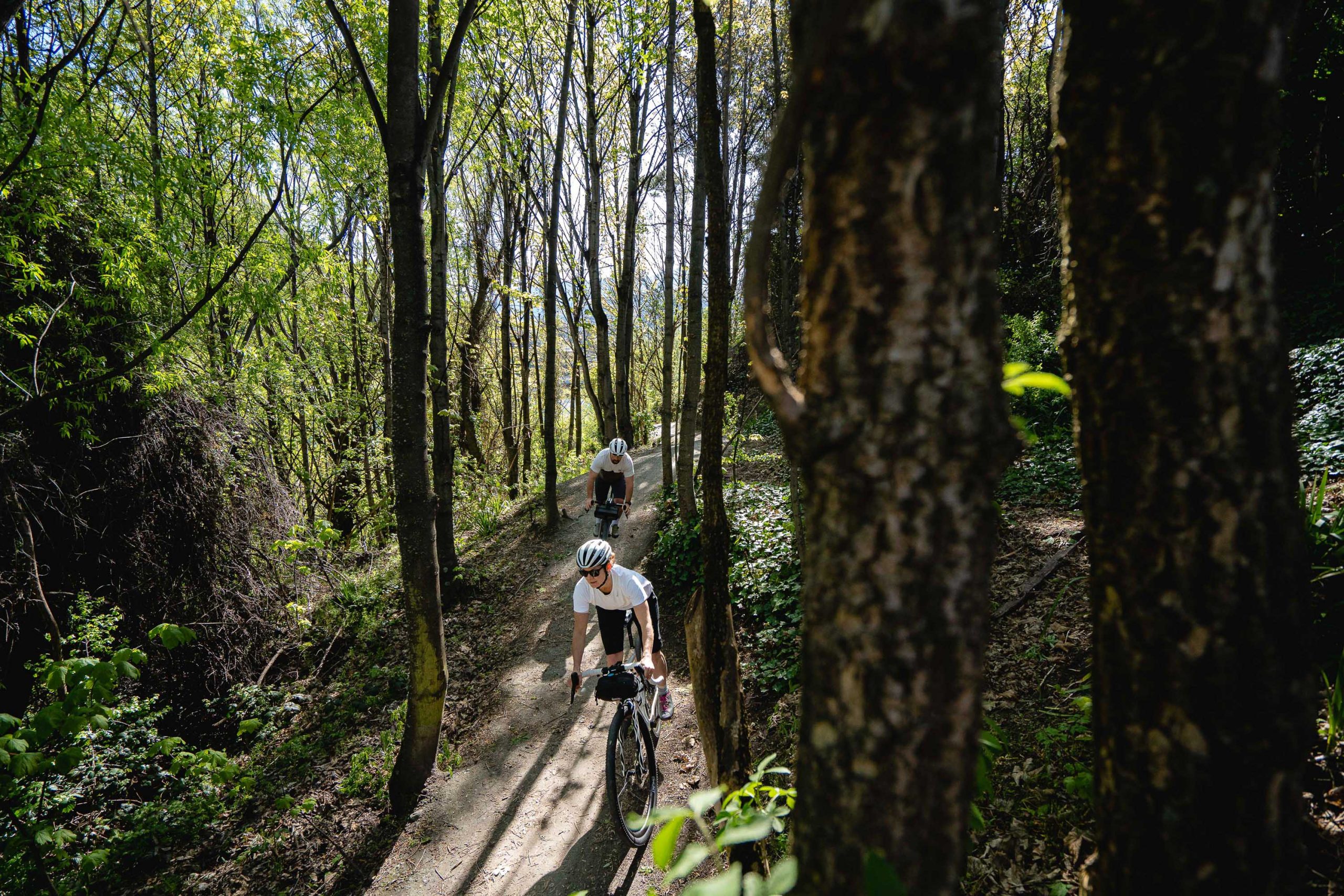
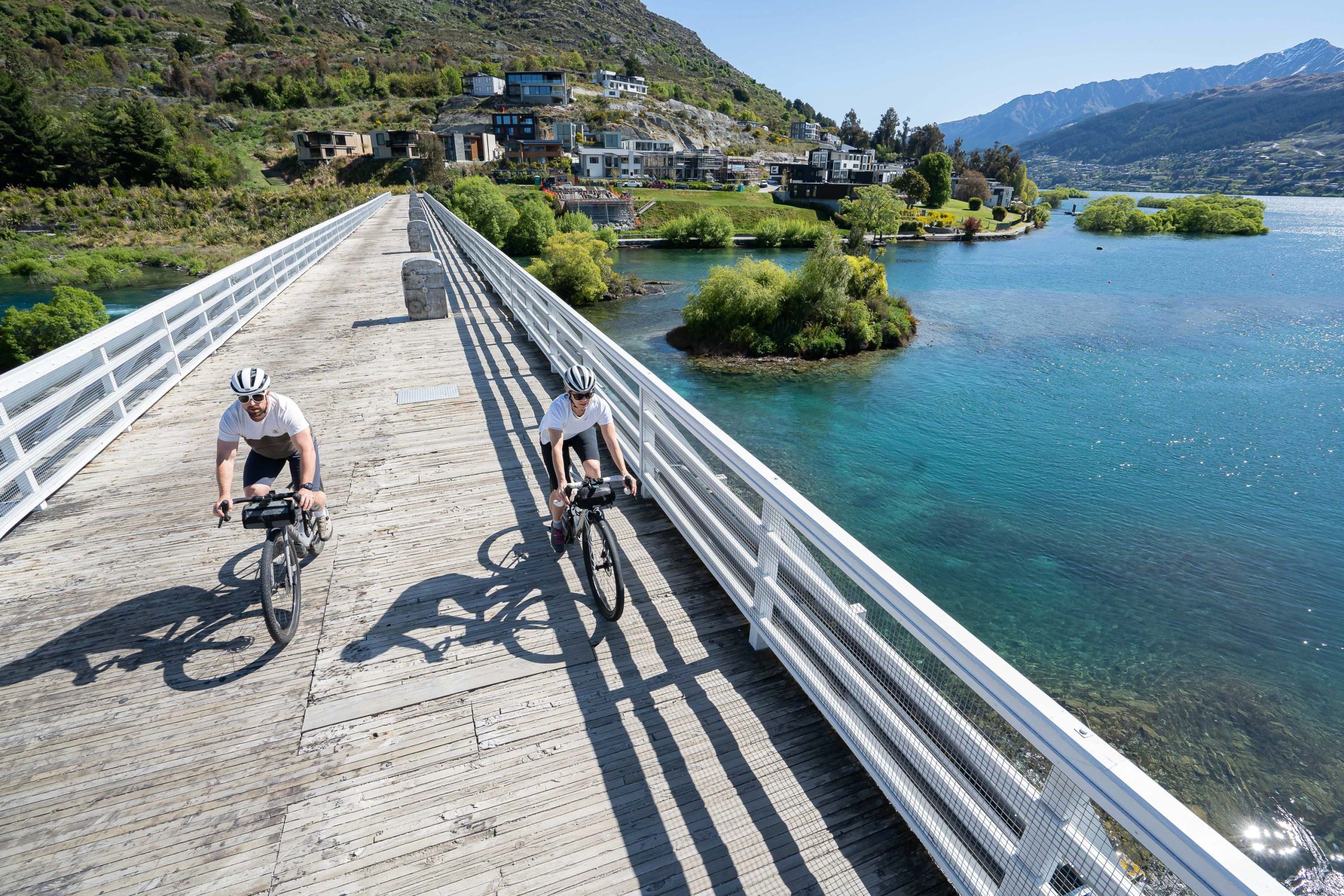
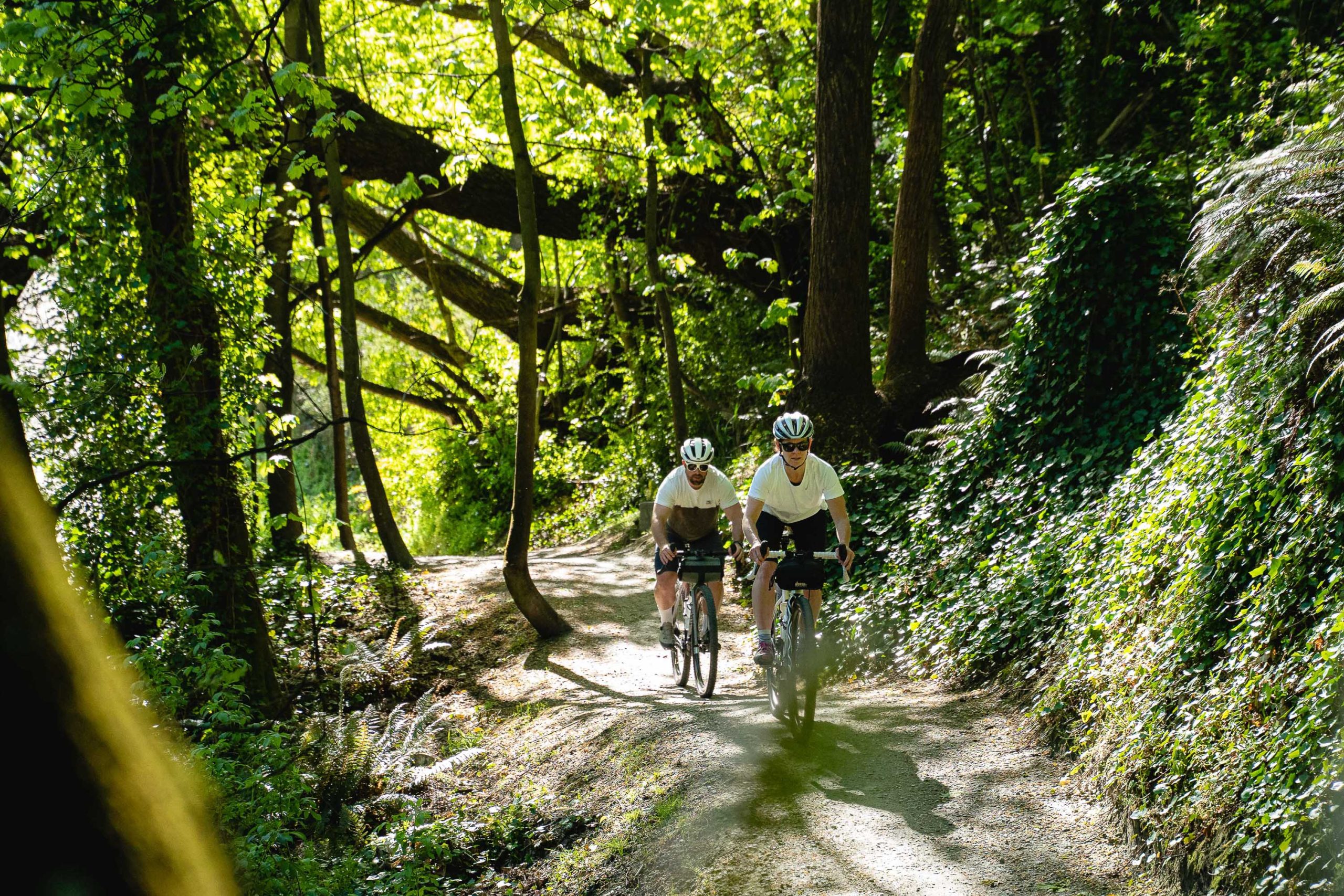
One of the best feelings, post-flight, is being able to hop on your bike and ride out straight from the airport – and that’s exactly what you’re able to do from Queenstown Airport. It also means you’re able to make the most of your time in this splendid region and, for me, it allows me to take in as much as I can of the surrounding area. We rode along the trail that would eventually connect us to Queenstown; meandering around the shores of Lake Whakatipu, which was glistening in the bright light of the afternoon. The endless tasks and thoughts that seem to constantly roam about my head were finally silenced, and my only focus was pedalling. I was excited about the next few days and the chance to connect some of New Zealand’s most incredible places by bike: Queenstown, Arrowtown and Gibbston. It was simple – ride, relax, wine and dine, then repeat. What’s not to like? It wasn’t long before we reached the edge of Queenstown, which was bustling as always. By this point we were hungry and thirsty for something other than water.
We pulled up at Atlas Beer Café and parked up in a sea of other bikes. This place has ‘post ride cold one’ stamped all over it, with many riders heading there after a ride. Atlas doesn’t just welcome riders, it celebrates the culture of the cycling world. The place is littered with bike paraphernalia and even has a bike hanging from the ceiling. They also give a ton of money back to the bike community and trails. Their beer list is extensive and their food is great without being overpriced or too fancy. It’s a place that welcomes you and wants to hear about your adventures. Our crew demolished a bowl of fries and a craft beer in minutes.
I’ve visited Atlas a few times before and always come back whenever I’m in Queenstown. It’s the relaxed feel, welcoming staff and bike culture that make me visit time and time again. On this occasion I met Matt McKinley. He’s a local chef and keen rider, so we yarned over a beer and shared riding tales. It’s evident he’s got not only a passion for food, but also cycling, beer and residing in this epic location. The connection we shared is what it’s all about: people and places that understand riding and riders. A delicious steak was served, with more fries, along with a slightly stronger craft beer.
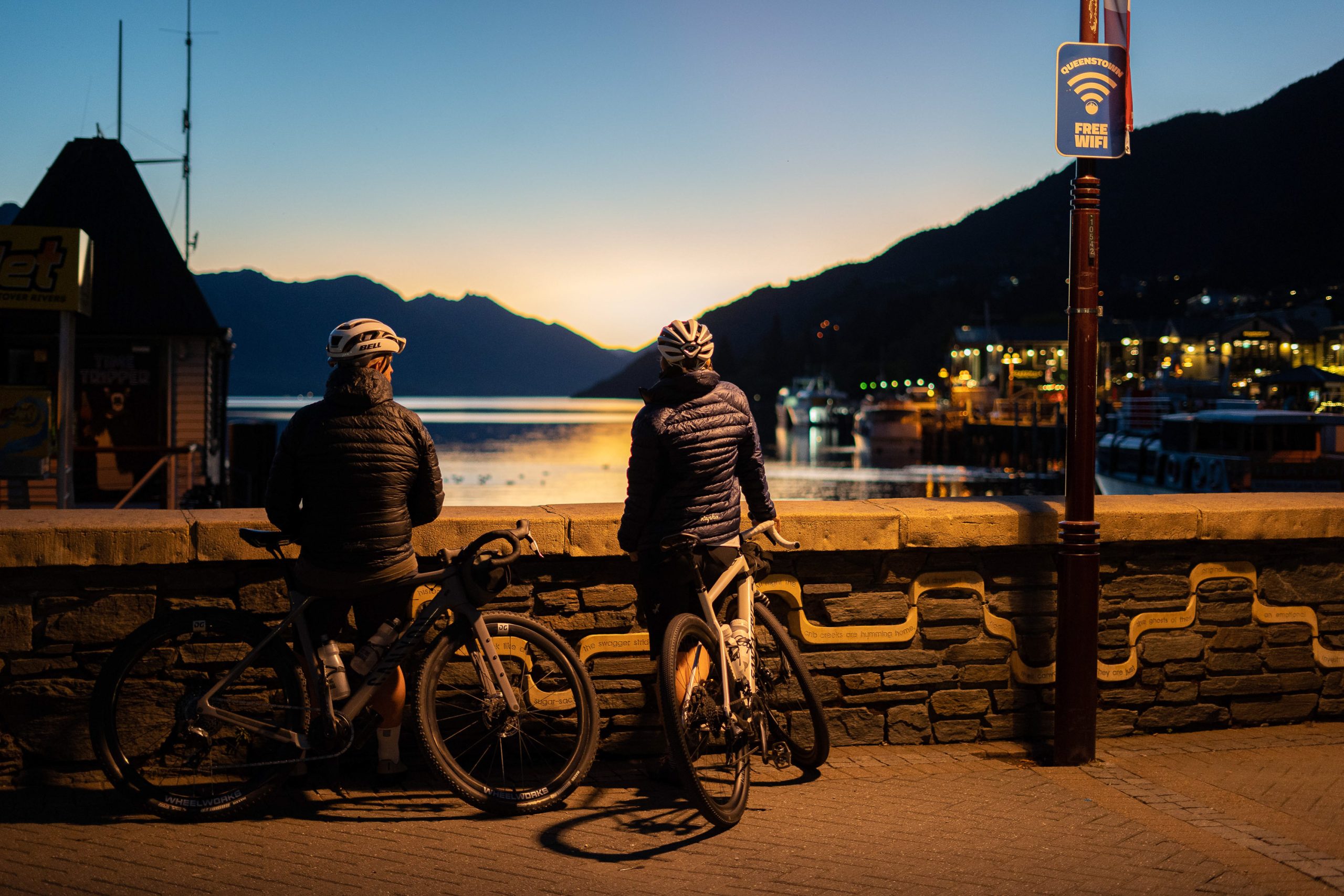
Our digs (accommodation) weren’t far from Atlas, so we grabbed our bikes and headed to Pinewood Lodge. We checked out the amazing sunset at the end of Lake Whakatipu then flicked our bike lights on and pedalled through the bustling streets. Pinewood Lodge is a bike-friendly place to stay that welcomes riders, and is located at the edge of town. They can store your bikes for you and have a variety of accommodation options. Our studio was private and well equipped with a hot shower and comfy bed – everything you need for post-ride relaxation. This is a great place to base yourself, friends or family for riding adventures in and around Queenstown. It’s very close to town, but still has a secluded feel.
We started our day early, as we needed to cover a fair bit of ground to get to the evening’s destination, Arrowtown. But, with that effort would come reward as, at the end of the day, we’d be visiting some of Arrowtown’s eateries. After a few brews at our digs, there wasn’t any shortage of intensity. We reached Old Lower Shotover Bridge, which was fully restored by the Rotary Association, in 2004. The bridge offered great views to Coronet Peak and the Remarkables. The Adventure Capital of New Zealand really lived up to its name as a jet boat whizzed under the bridge, filled with screaming punters. It seemed we were all there for the same reason, just using different modes of transport to discover and explore the landscapes. It wasn’t long before we were pedalling towards Arrowtown. The town, and landscape of the suburbs, soon became rural countryside, dotted with luxurious homes. The trail runs true south of the river and pinches up over a few climbs, ensuring our legs were awake.
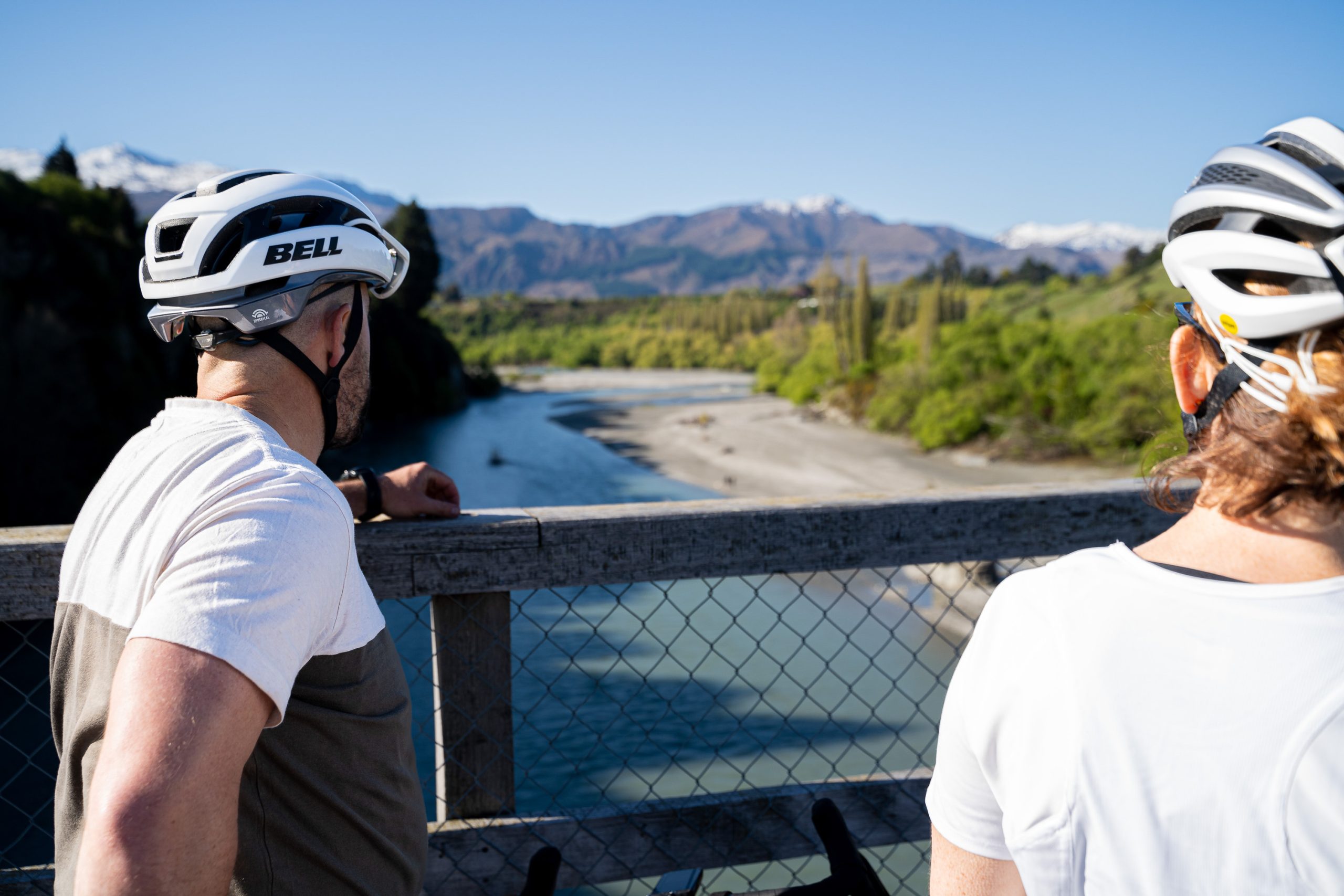
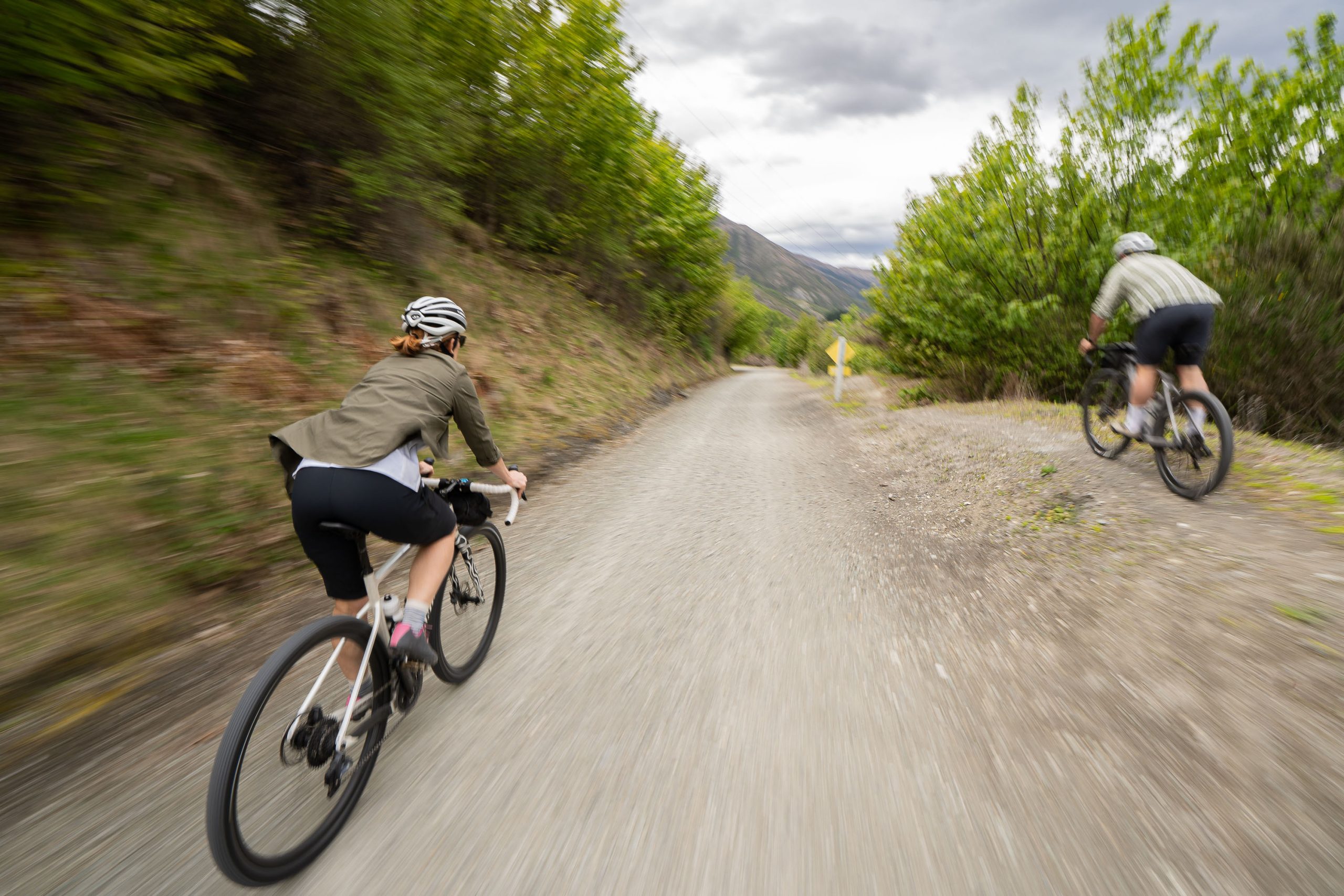
Soon enough, we approached the edge of Arrowtown. I’ve visited the area before and continue to come back – it’s just so damn pretty, and riding a bike through the streets really enables you to relax after a day on the trails. Arrowtown sits in the Arrow Basin, which was carved by the great glaciers of ages past. Before European settlers came to New Zealand, Māori walked through the area on seasonal trips, to hunt native birds and find the prized pounamu (greenstone). In 1862, gold was discovered in the Arrow River and, a year later, the miners pulled out 340kg of the yellow treasure. In 1865, economic times were tough, so the Otago Provincial Government invited Chinese miners to come and work. The small Chinese village they created in Arrowtown stayed settled until 1928, and its remains are part of Arrowtown’s history. Nowadays, around 70 buildings and features are left over from the gold rush era, and the town is as popular with holidaymakers as it is with people interested in our country’s rich history.
The Dishery welcomes bikes and riders with racks out the front, which we parked our bikes on with ease. We ordered and told the enquiring staff about our ride as they served up divine poached eggs with a few cups of coffee. The eatery is located in a great setting with large, beautiful trees overlooking the old Chinese village. With the day’s effort done, it was time to relax and take in the sights. We pedalled the historic streets which, for me, emphasised how simple everything becomes when you’re aboard a bike – it really allows you to take in the environment at a slower pace. You can’t help but reflect on times gone by and it made me think just how hardy the people that came here in those early days really were!
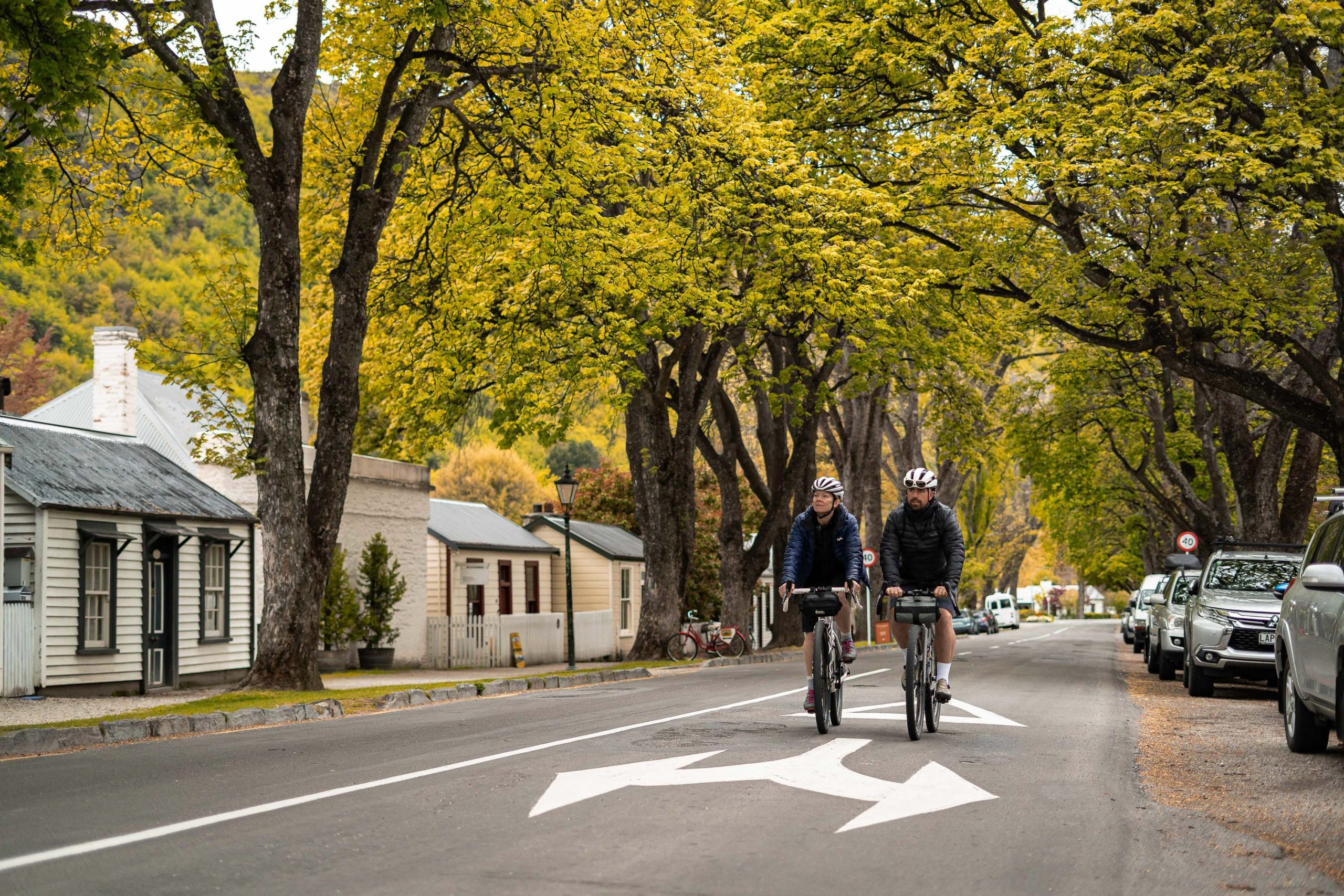
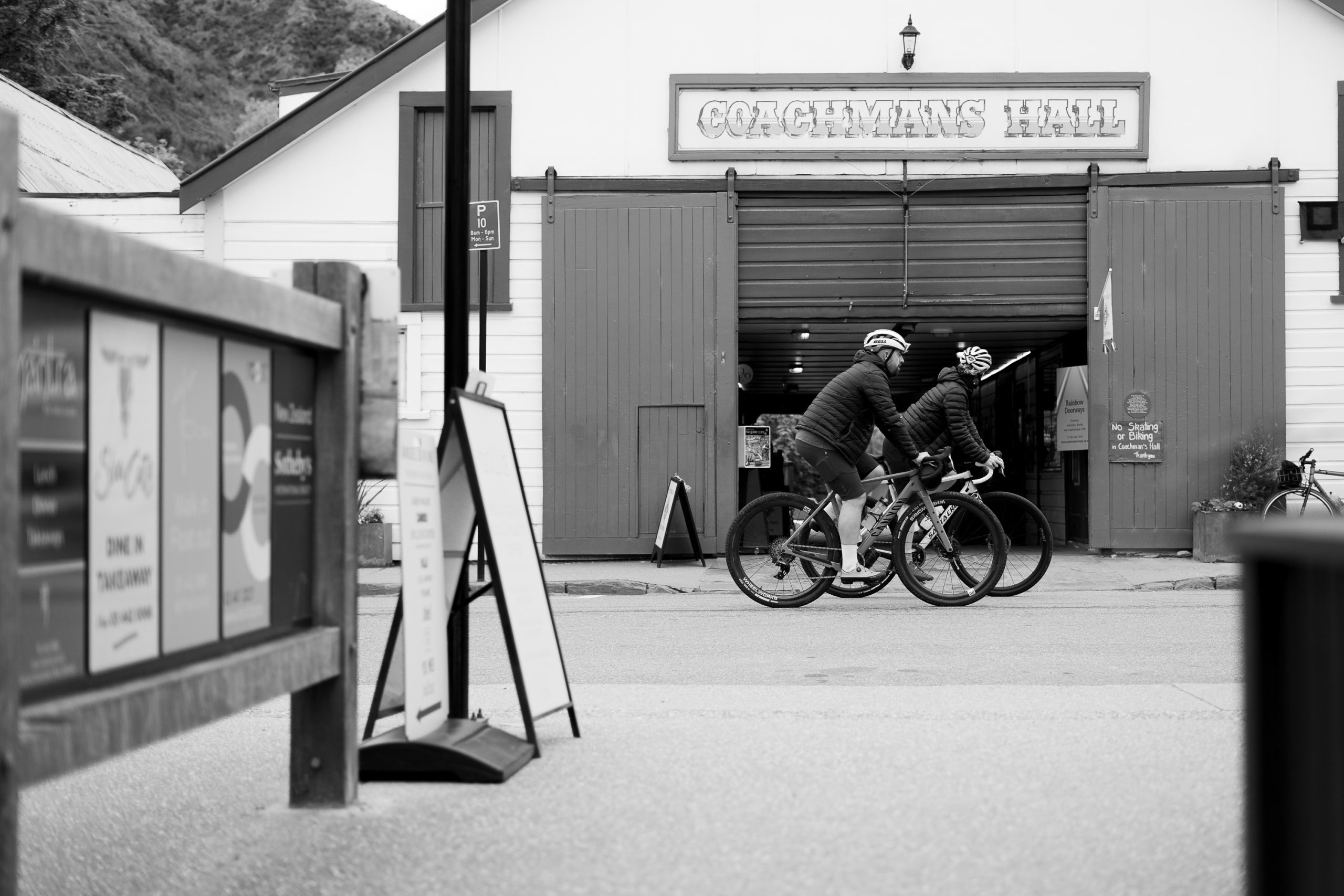
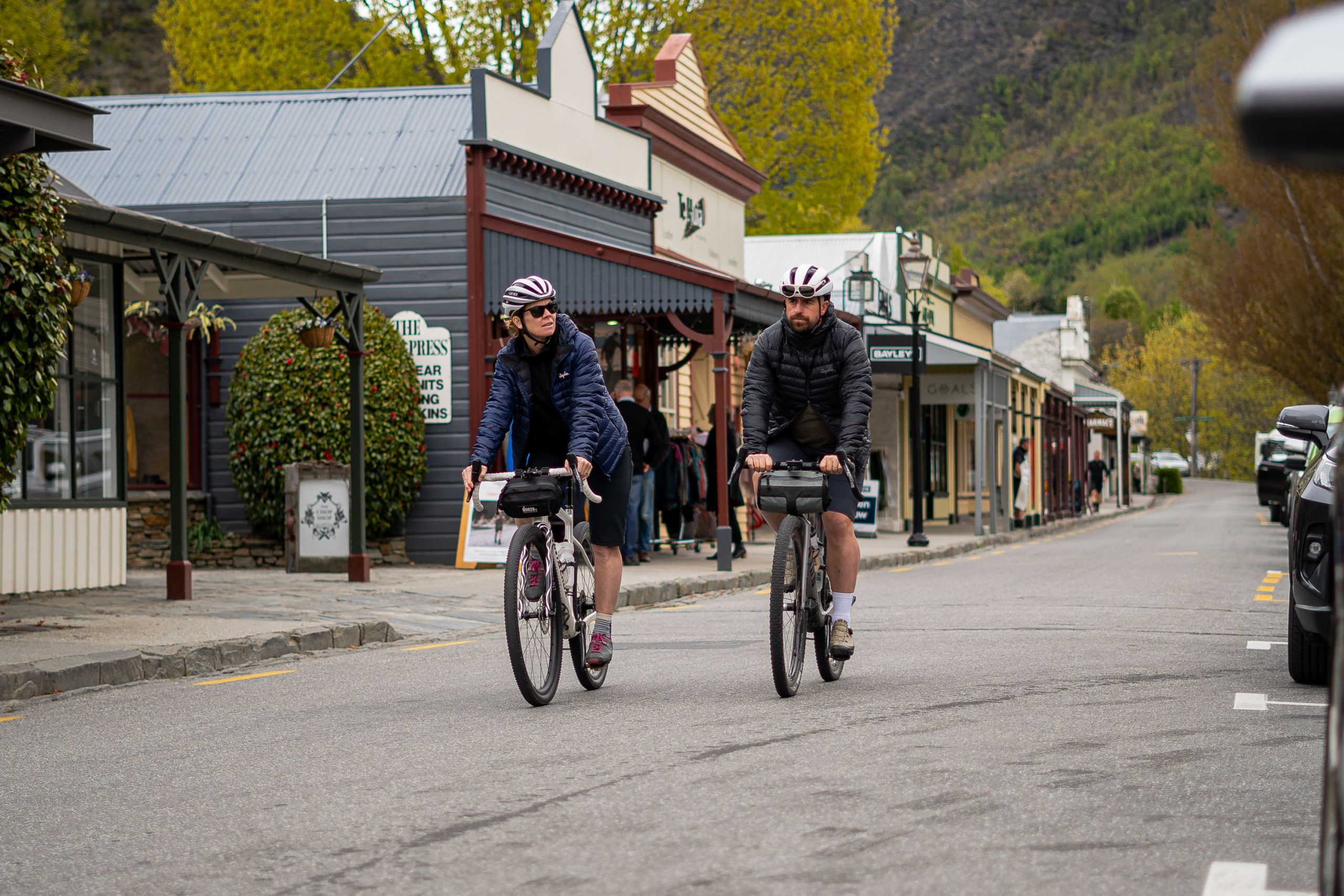
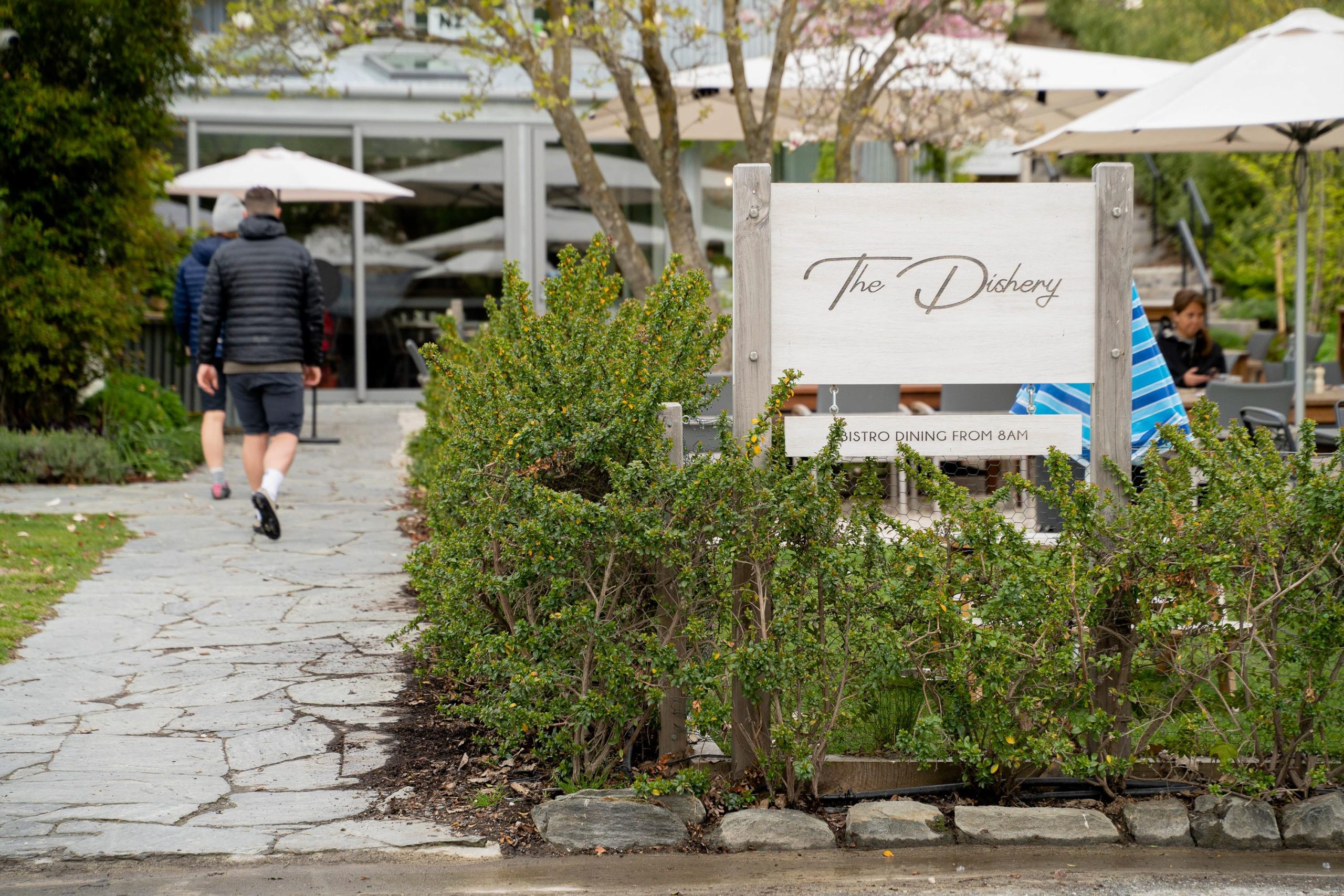
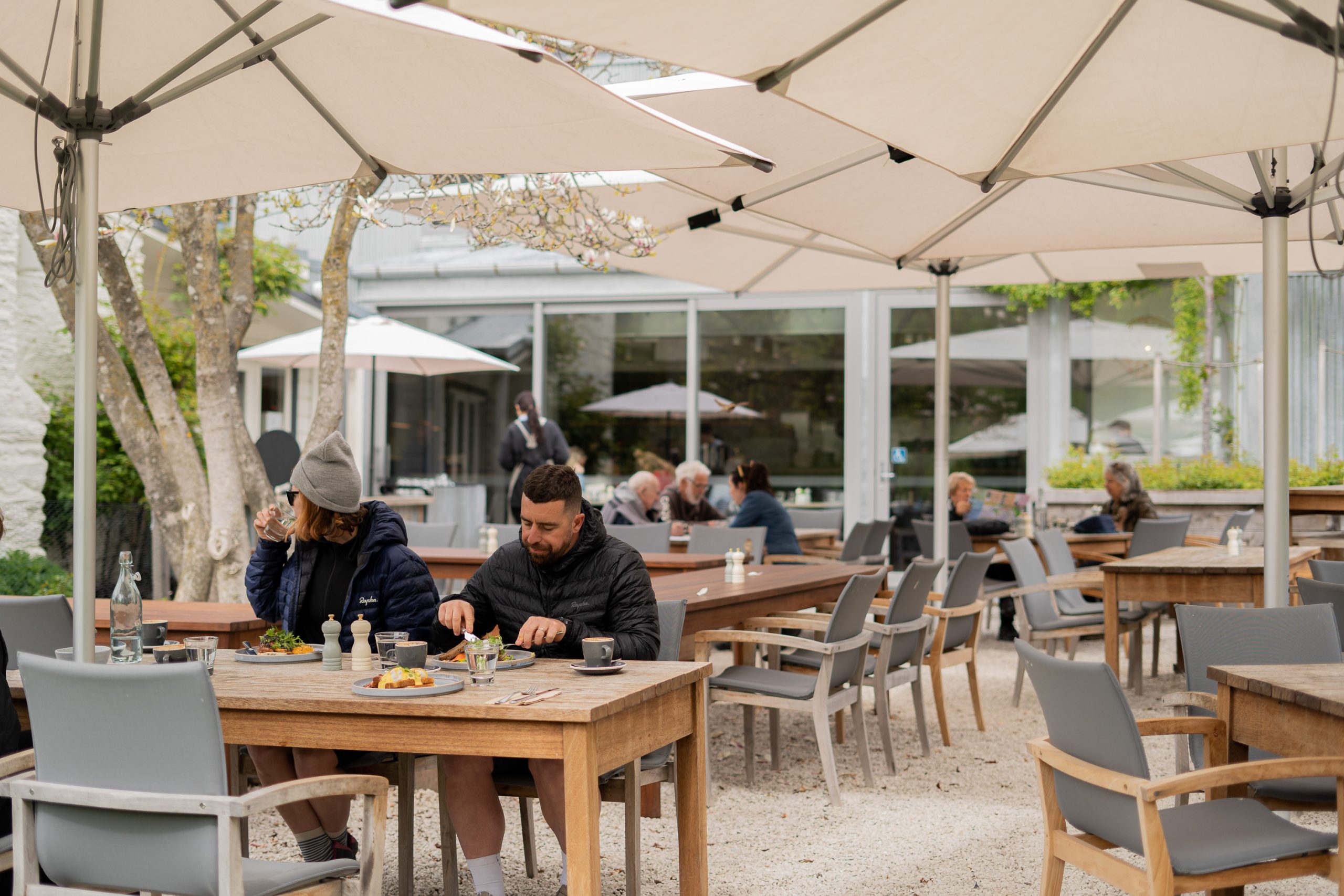
We grabbed our bikes and rolled around the corner to check into the Arrow Hotel, our accommodation for the night. I like the nice rhythm that goes with riding from destination to destination. It’s just so simplistic and makes you really appreciate the small moments, landscapes, and experiences along the way. Having your luggage transported makes things easier and keeps your bike light – it was so nice to check-in at Arrow Hotel, store our bikes and pick up our bags. The Arrow Hotel is super modern and has stunning surrounds; the open plan apartment really lets the incredible landscape in. What’s better is that it’s located on the bike trails, allowing you to access the myriad rides Arrowtown offers. We washed up, relaxed for a while, and took moment to stop and just be – something we don’t get much time for in the fast-paced lives we lead.
That afternoon, we headed to Fork & Tap, which is nestled in Arrowtown’s heritage precinct on Buckingham Street. This building has served many purposes in its almost 150-year life span. Today, it’s a welcoming spot for the community and visitors alike with great gastro food on offer and an impeccable line up of the best craft beers you could find anywhere. It has the perfect mix of locals and visitors, and a ton of atmosphere. Like so many places in the area, the vibe is very accommodating of riders and the staff are interested to hear your ride stories. We met the owner, Jeannie Hamilton, and she shared her enthusiasm for the community, the Fork & Tap, and riding. This spot has become an iconic watering hole and, even on a weeknight, the atmosphere is second to none. Jeannie is passionate about the region and, over the past few years, has really seen more people explore the place by bike. She’s even caught the riding bug, too! Over the winter, the local male riders meet every week for a night ride and a drink at the Fork & Tap. The women thought they’d better start their own group and now have an active bunch of riders who meet up every week, too. This group has become a real hit, with more and more local women coming along on their bikes each week.
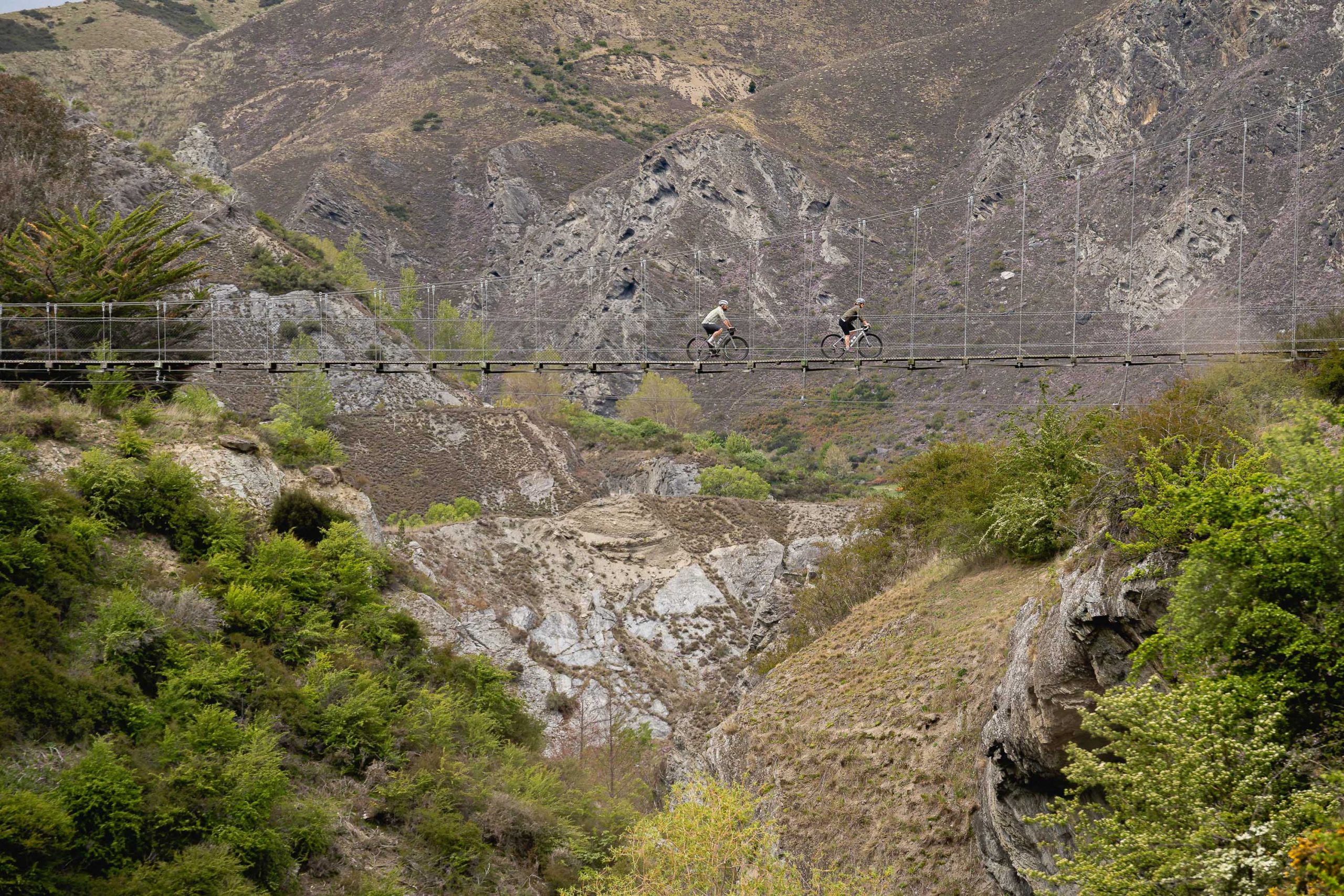
Another good bloke we got to meet was Mark Williams (also known as Willy). Willy is a prominent Queenstown mountain biker and former sports store owner, and is now the chief executive of the Queenstown Trails Trust. I managed to ride with him towards the back end of this trip and will share that tale with you all soon. It’s clear when you meet Willy, he’s got a lot on the go! Whether it’s building or scoping new trails, training for a multi-day stage race, pre- paring for a big adventure, or just hanging with the family – I got the sense he’s not a guy with much down time. The culture of the great outdoors is ingrained in Willy, which seems to be the case with most people that reside in this mountainous wonderland. What’s evident with Willy, however, is that he really ‘gets’ riders and riding, and the need for areas to be accessible by bike. Not only that, but he wants to make the link between conservation and trail riding greater and believes the more we can open up areas and get people in, the more we can get them to understand conservation needs. I can’t wait to see and learn more about the projects he has on the horizon, and I know that, with Willy at the helm, the Queenstown Trails Trust will be taken in the right direction. That evening, we headed to Slow Cuts – an institution in Arrowtown. Their slogan reads; ‘Fast food in slow motion’ and they offer rotisserie chicken, burgers, ribs, smashed potatoes, slow cooked meats and seasonal salads. I can vouch for the rotisserie chicken with a side of cauliflower and spinach fritters. Again, the drinks menu is extensive and features some very tasty craft beers.
The next day dawned and, fuelled and well-caffeinated, we headed downstream of the Arrow River, onto the Arrow River Bridges Trail. The route zigzags across five bridges, including the Southern Discoveries Bridge and the 80-metre-long Edgar Bridge. Both are suspension bridges with stunning views. The trail ebbed and flowed, much like the river below, and we continued to press on the pedals, meandering towards Kawarau River and eventually Gibbston. Quaint cottages and grazing horses and Alpacas lined this Whitechapel country lane.
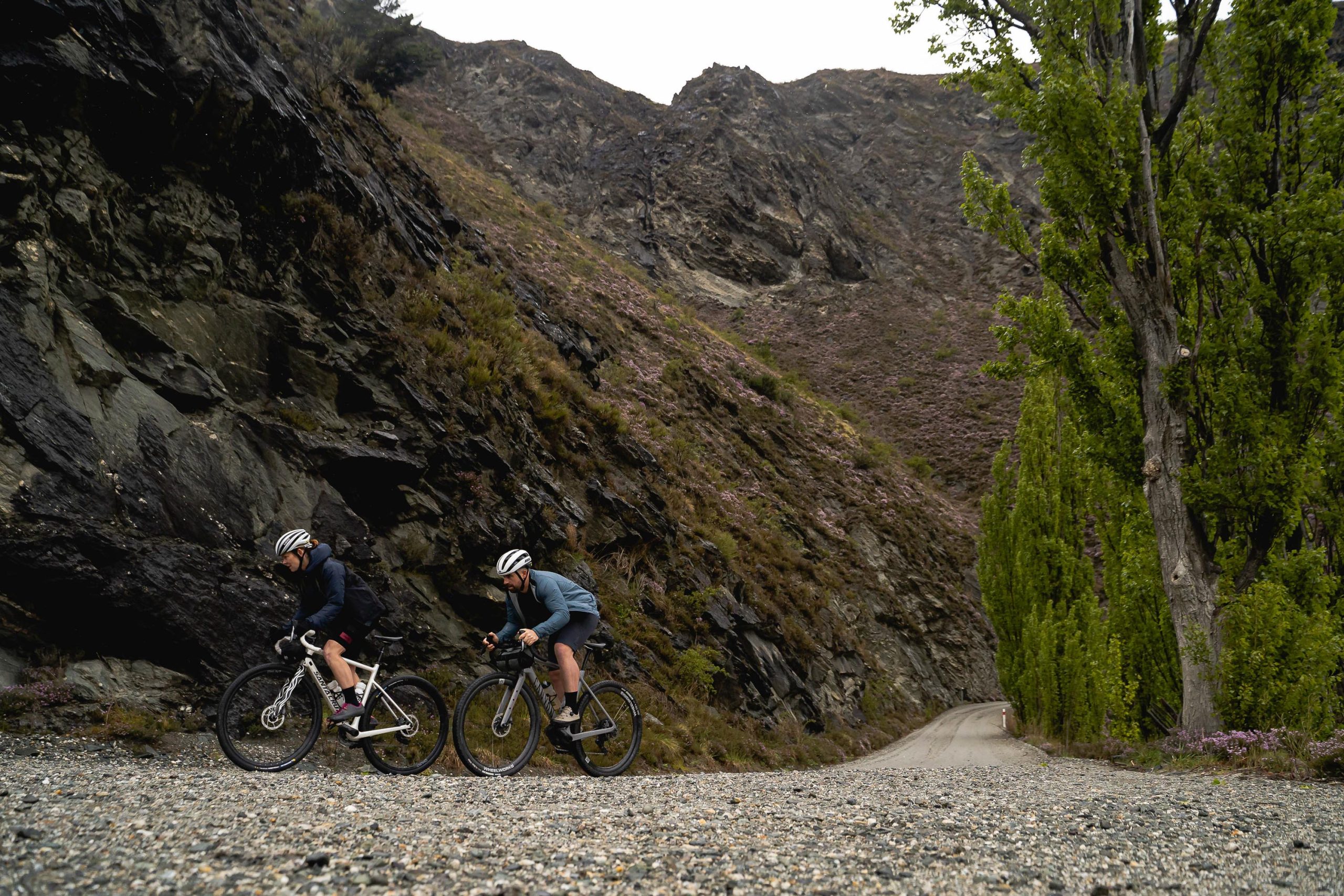
The Edgar Bridge sits high above the Arrow Gorge and makes you really appreciate not only the land but the incredible engineering feat of the bridge itself. From here, it’s evident we were traversing into more rugged, remote and arid landscapes. The trail dances beside the Kawarau River with its steep gorges and breath-taking turquoise water. Another engineering feat, and the perfect spot for thrill seekers, is the AJ Hackett bungy that sits on the Kawarau Suspension Bridge. The cycle trail stayed high above the rivers banks as it rolled us straight into the vineyards of Gibbston – a great place to arrive for an afternoon snack and tipple.
An adventurous spirit is at the heart of the region, how- ever, quality fare, wine making and hospitality truly make it shine. That’s why connecting the two – bike and wine – make so much sense. Not forgetting, after all, that this is called the ‘wine trail.’ Riding through it makes you feel more connected to the land of vines – the trail takes you in, out, and some- times through, these wineries, often dodging winery dogs or sprinklers. Seeing it all first-hand really connects you to the process behind the bottle.
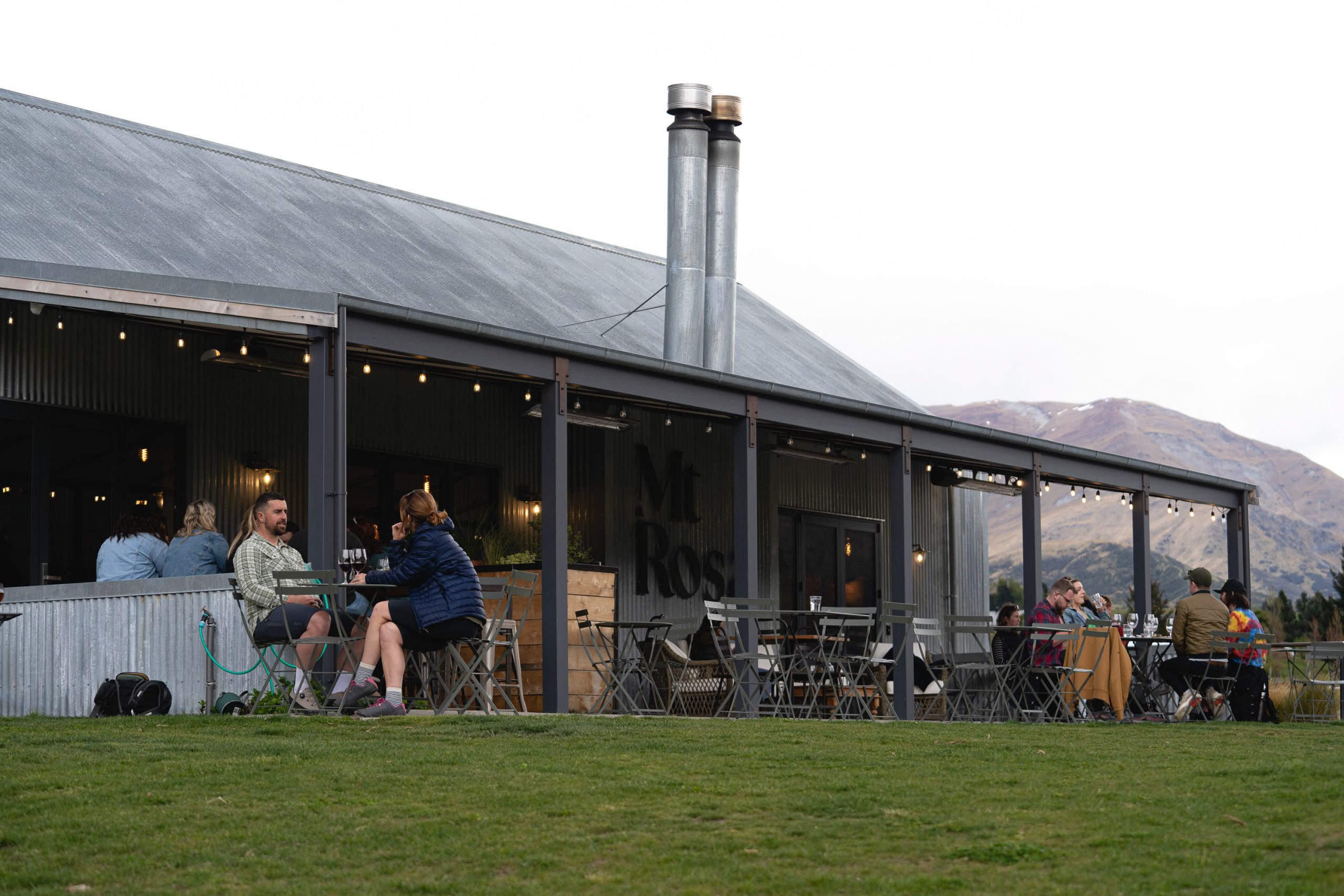
The day’s jaunt brought us to the cellar door of Mt Rosa. Bike parking is provided out front and a warm smile from old mate on the stairs welcomed us in. Mt Rosa is in a relaxed, rural setting, nestled amidst rows of vines and surrounded by incredible mountains and hillsides. Turns out, old mate was Guy Boanas – the owner of Mt Rosa along with his wife, Ann. He’s a real southern bloke with short shorts, a working man’s shirt, woolly socks and boots, topped off with a rattan hat. He’s a real bloody dag. We sat outside sipping on their divine Pinot Noir with a shared platter of Turkish bread, dukkha and hummus, and had Guy join us. Together, we talked about the transformation of the land from high country sheep farming to wine making – the last 20 years has been all about wine and, more recently, a brand-new, purpose-built wool- shed style cellar door was opened. It’s still got its farming roots, with a woolshed aesthetic, but has a touch of class as well – without feeling pretentious. It didn’t take long before we were on the phone to my father in-law, a wine enthusiast, discussing which case to purchase him (four days later it arrived at his home in Taranaki). What stood out to me was the relaxed atmosphere of this cellar door, it’s got a real family feel, tasty food, great wine, a stellar backdrop, and everyone is welcome – even if you’re wearing riding apparel! Thankfully, it was only a short pedal to Kinross Vineyard and Cottages (our digs) for a late lunch. The lights dangling in the dining area made it feel like a runway for parking up our bikes. Kinross is located on the old Kinross Station in Gibbston Valley, established in the late 1860’s by pioneering Otago farmer, Thomas Kinross, who ran a thriving Trading Post, farm, and gold agency on this site. Nowadays, 100-year-old Pinot Noir vines sit pride of place on the land, with the Nevis Bluff standing tall above the winery.
A delicious afternoon off the bike soon followed, filled with pizza, salads, and wine tasting. I think the ability to have a morning filled with riding, and an afternoon spent wining and dining, is a rather nice combo. The pizza, salad, beer, and wine were served in an outdoor setting, nestled amongst the hills. The pizza was simply superb and didn’t stay on the table for long. The wine tasting that followed was intimate – a nice way to learn about the wines that Kinross produce. The stories behind the wine making are always intriguing, as is the spirit of the people who choose to work the vines.
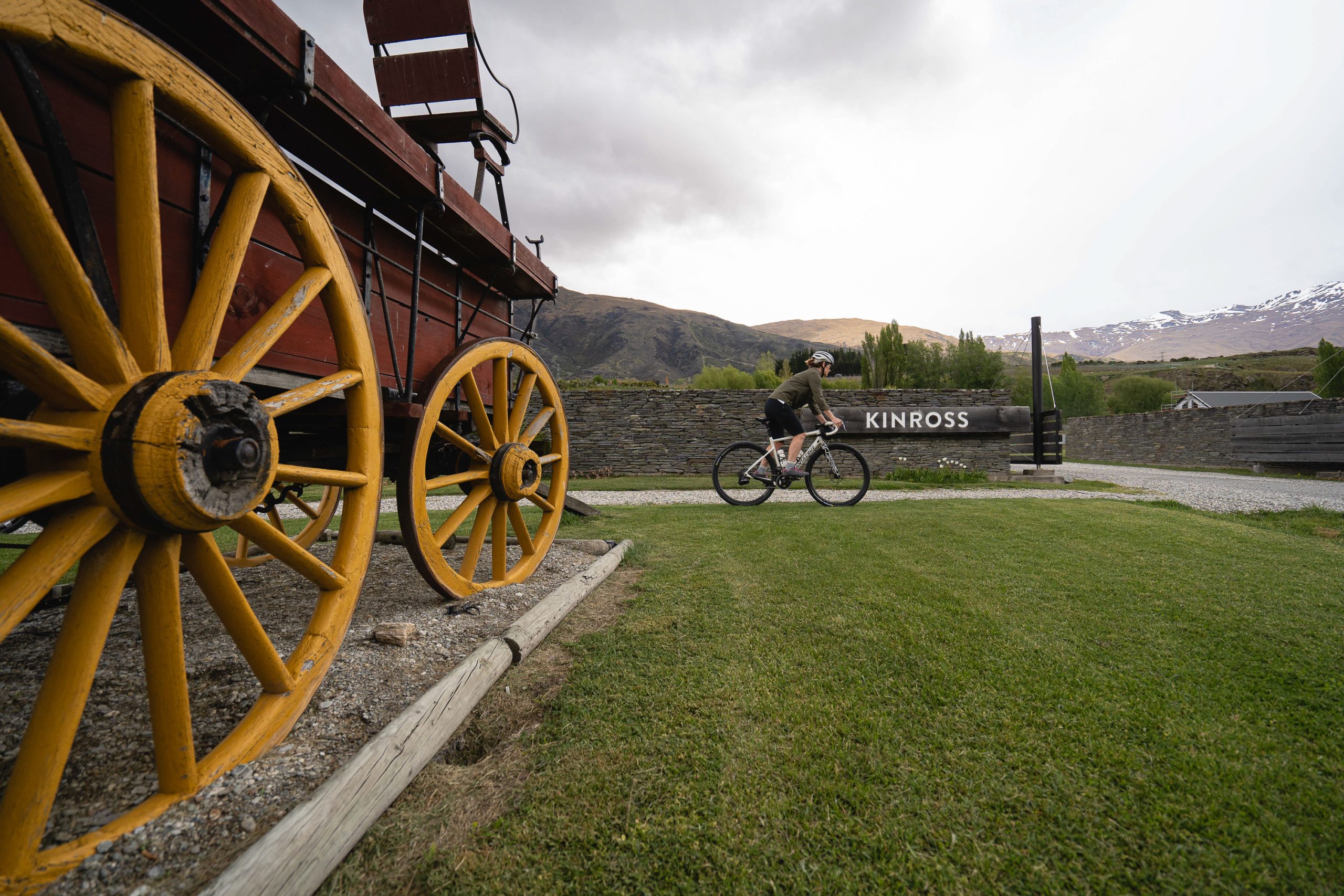
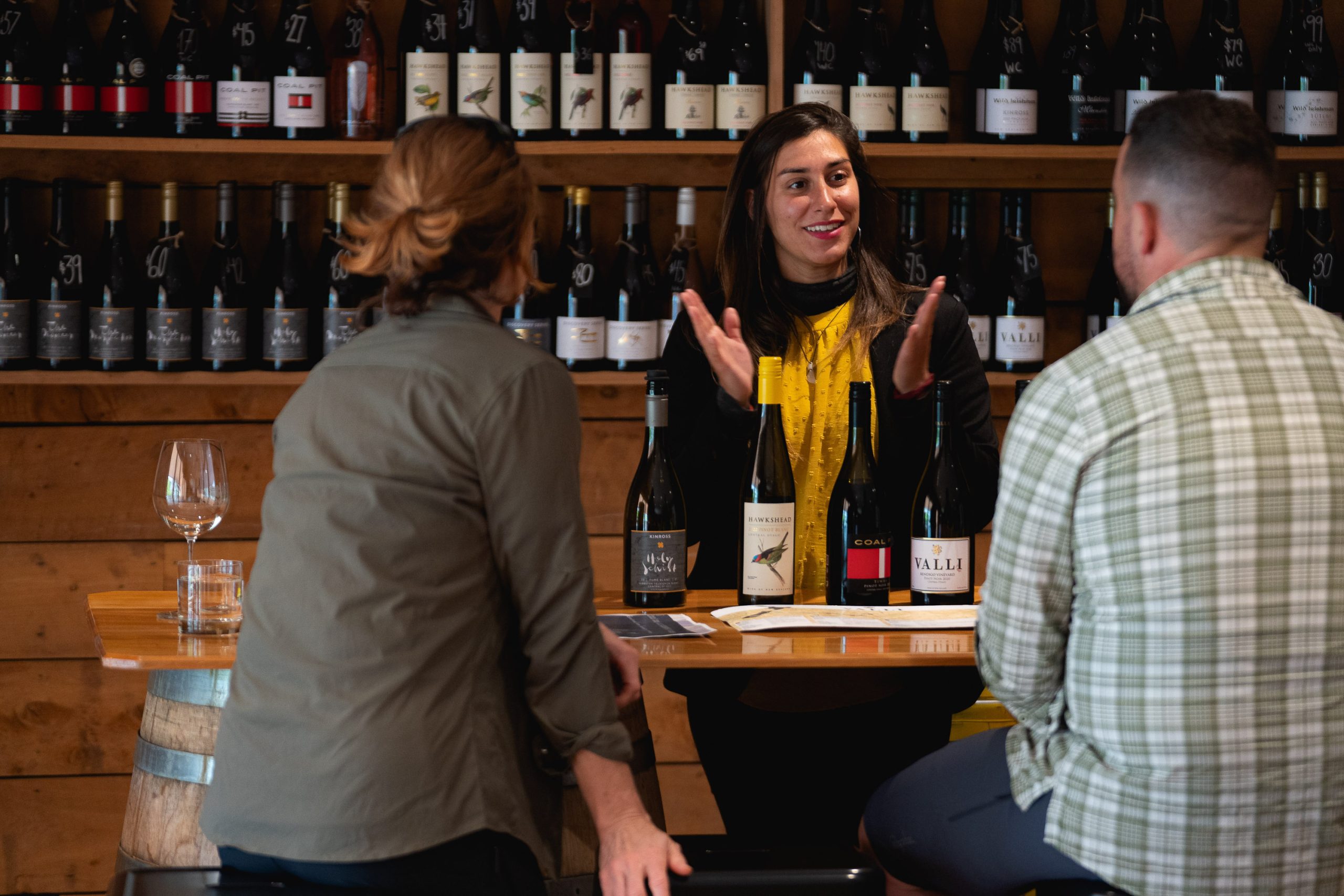
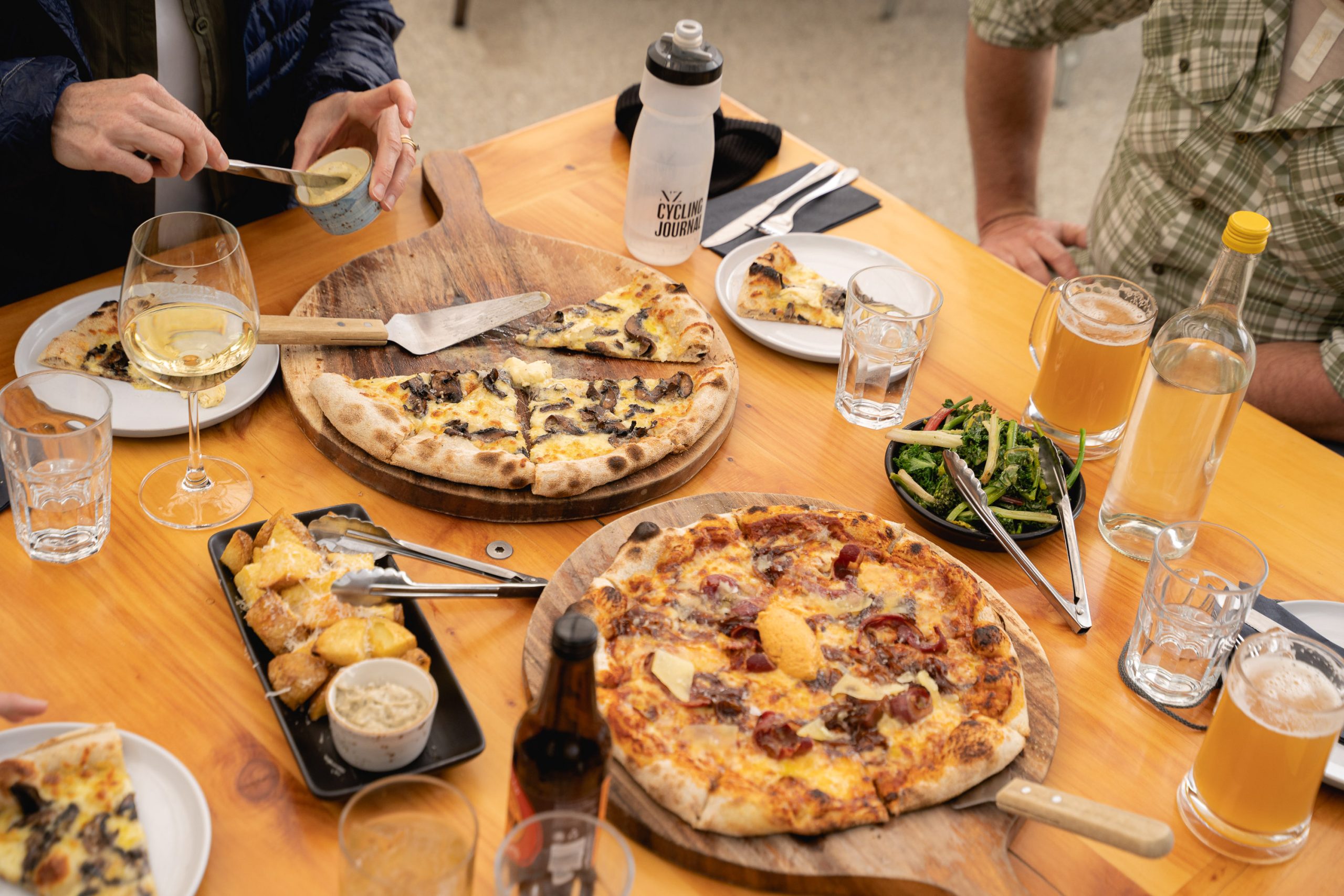
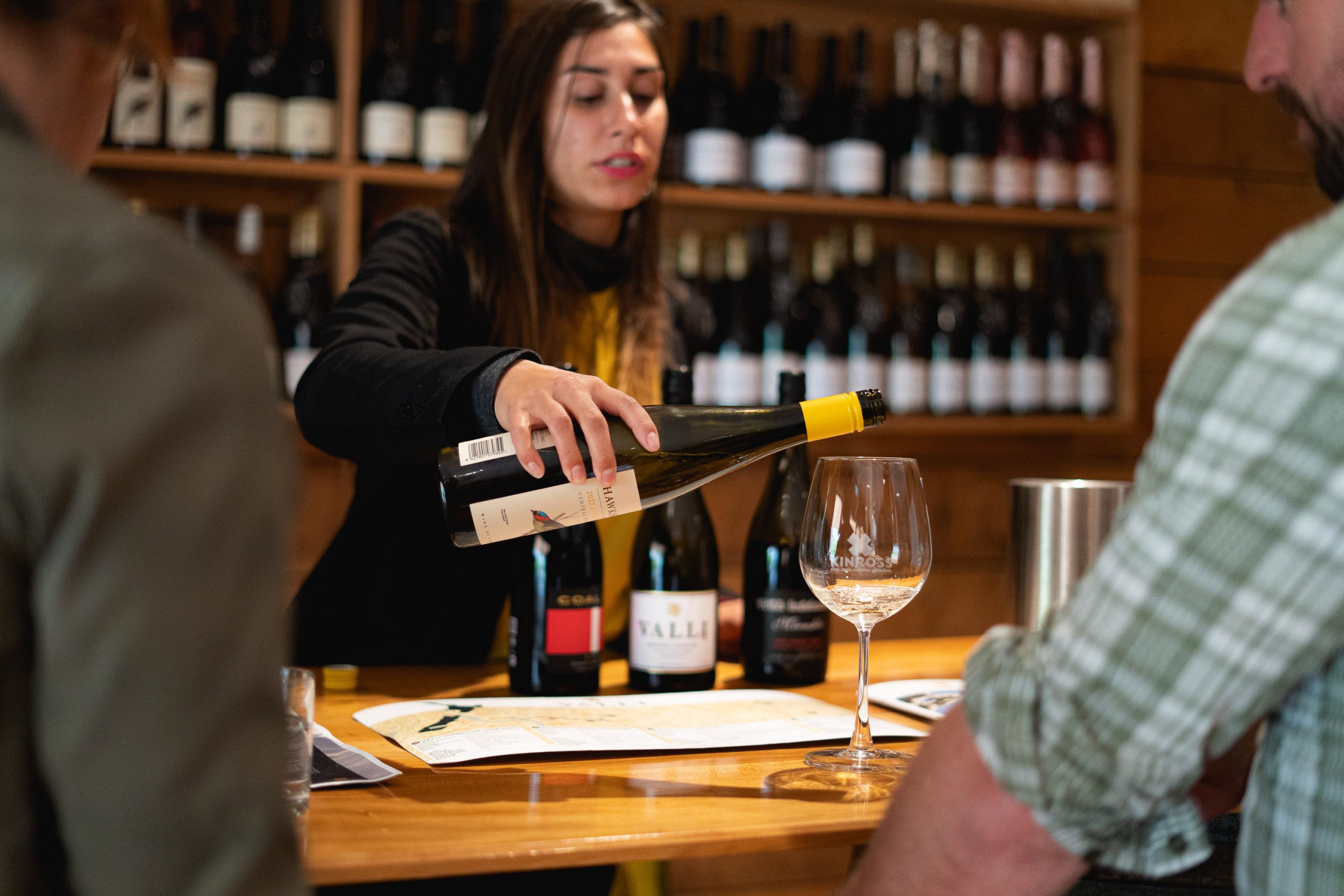
As mentioned, our night’s stay was at Kinross Cottages. This accommodation exudes cosy character and rustic design, paying tribute to the pioneering spirit of 19th century Central Otago. The cottages are located in a stunning vineyard, which is super convenient if you want to enjoy a glass or two of wine – plus, it’s right on the cycle trail. We parked our bikes and cast our eyes over the breath-taking Pisa Range, which overlooks the boutique accommodation. We sat out on the porch eating dinner, which was a hamper filled with delicious treats, and enjoying a glass of Kinross ‘The Pioneer’ Pinot Noir. The setting was idyllic and very restorative. I had to be reminded that we still needed to ride our bikes the next day.
A new day dawned, and we awoke to rain pouring down on the tin roof of our chalet. I buried myself deeper under the duvet and hoped it’d go away, or at least subside. Eventually, I needed coffee and had to get up. Pulling back the curtains revealed low, dark clouds hanging over the Pisa Range. A coffee in hand, I contemplated the day’s relatively short – but possibly wet – journey ahead. But before we even began that task, we needed to tackle the breakfast task; a divine spread was laid out for us at Kinross, alongside a roaring fireplace. I think I had three rounds of pastries and way too much coffee, however, by the time we were finished the rain had ‘sort of’ cleared.
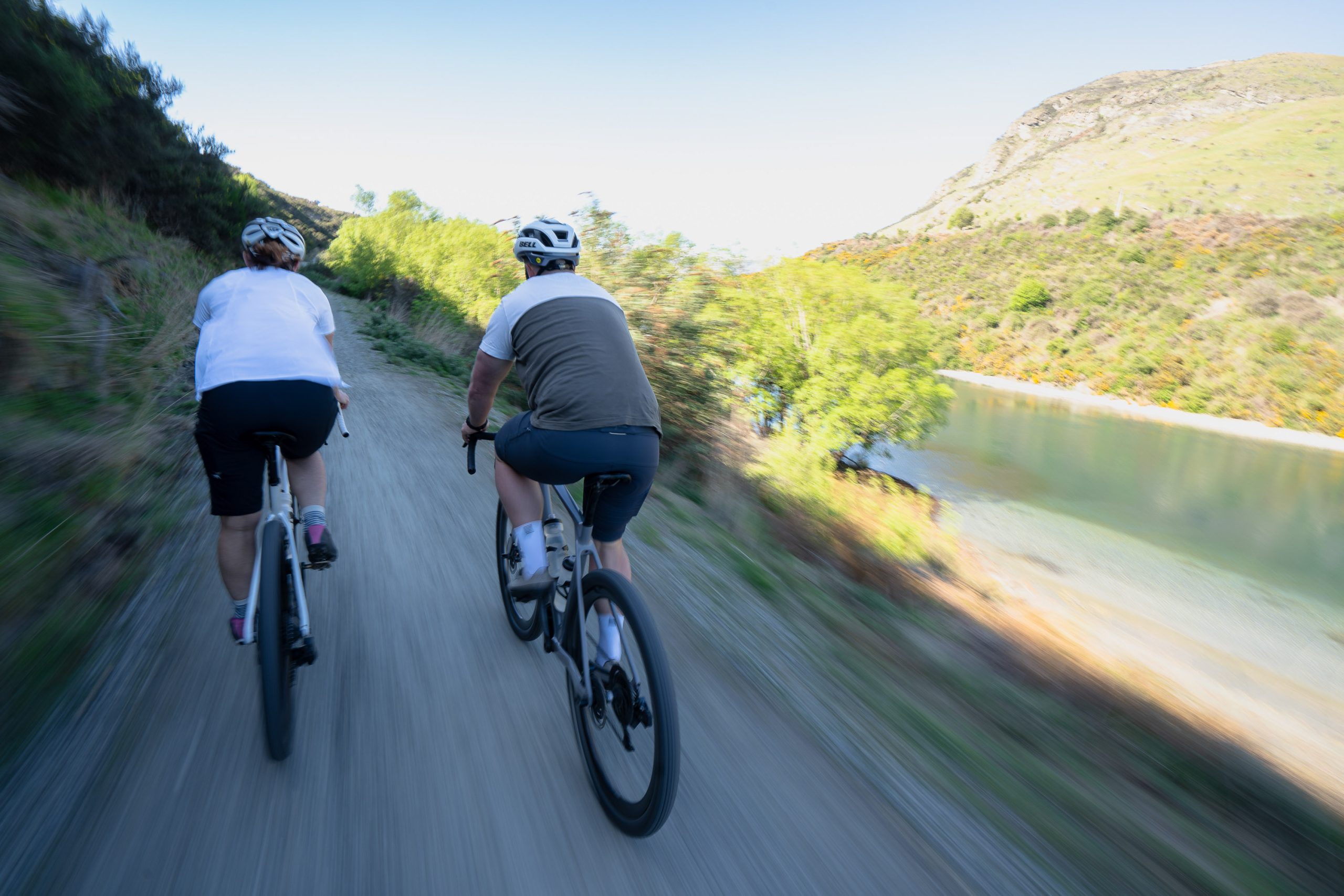
We saddled up and ventured back onto the trails we’d come in on the previous day. Heading in another direction on the same route means you often get to see different landscapes and views. This time around, we could appreciate the views as well as the in-climate weather that lingers in the mountains. The Kawarau River was still spectacular but had a touch more mood to it. We spotted a waterfall running into the gorge, which we must have missed the first time around. The black clouds crept lower down the mountain ranges and within moments it was raining again, but I didn’t mind. Riding in the elements makes you realise you can dig a bit deeper – and makes the grub at the end taste so much better! The constant movement of riding allowed us to really take in the different scenes, rather than just rushing past them as you would in a car. The trail has so many different sections to it; river crossings, wine trails, mountainous landscapes – the land just sort of encompasses you in it. The trail sections are all spaced apart perfectly, meaning there’s plenty of places to stop for much needed sustenance. It allows you to really appreciate Queenstown’s ability to blend good riding and great hospitality – which truly is second to none.
The desire to explore and discover is what binds riders of all shapes and forms together; it’s our common ground, no matter our pace, experience or skill level. Queenstown and its neighbours let you discover and re-discover at your own pace, providing quality accommodation, unrivalled hospitality and world class wines along the way.
For maps and more info, click here.

